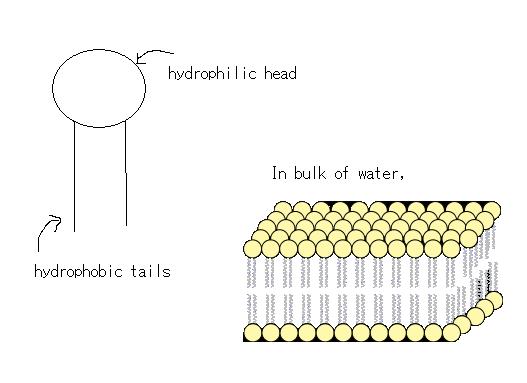
|
|
|
カテゴリ:物理とそのへん
今日はICC(TAをやっている留学生のための英語のクラス)でプレゼンをやった。
せっかくだから記録をしておこうと思う。 個人的にx-rayとrigidityの関連性を直感的に理解できるようになったのは嬉しい。以前は、理論はわかるんだがなぜX-rayを使って膜がどのくらい硬いかがわかるのかが理解できなかったからね。 断っておくけど、見ての通り英語です。文法もめちゃめちゃです。たぶんこんな感じで喋ったんだろうな、というのを文章にしてみただけです。 書いておかないと忘れちゃうからね。 いつかきちんとした日本語で書きたいとも思うけど。 -------------------------------------------------- (追記) rigidity: 剛性 stiffness: 硬さ、硬度 lipid bilayer: リン脂質二重層 cell membrane: 細胞膜 biological membrane: 生体膜 property: 特質、特性 scatter: 散乱させる、拡散[散在]させる flexible: たわみやすい、曲げやすい -------------------------------------------------- Lipid Bilayer: A lipid bilayer is a major component of a cell membrane, which separates the interior of a cell from the outside environment. It controls the movement of substances in and out of the cell. Another place where lipid bilayer is found is a virus. Its encapsulation of DNA is provided by lipid bilayer. (need to rephrase) Understanding the physical properties of lipid bilayers helps us better understand how, for example, a cell interacts with a virus, which in turn helps us develop better drugs. In this talk, I will describe to you what a lipid bilayer is, x-ray technique that we measure its physical property with, and then tell you an intuitive way to understand how x-ray can actually tell you how rigid a membrane is. First, I want to teach you what a lipid bilayer is. To do this, let me start off with describing what a lipid molecule is. A lipid molecule is an organic molecule that has a hydrophilic head and two hydrophobic tails. Here, hydrophobic means that the head likes to stay near water, whereas hydrophobic means that tails like to stay away from water. So, when you throw in a bunch of these molecules in water, what happens is that these molecules self-assemble, or arrange themselves into a structure called lipid bilayer, which is a thin sheet consisting of lipids.  As you see from the picture, you have two layers of lipid molecules, and this is why it is called lipid bilayer. (underline bi) . This is a very small object, and its thickness is only 5 nanometer. Now that I've briefly told you what a lipid bilayer is, let me explain the method with which we measure physical properties of the lipid bilayer. We use x-ray to study membranes. X-ray is a form of electromagnetic waves just as optical light that our eyes are sensitive to is an electromagnetic wave. The difference between x-ray and optical light is their wavelengths. Optical light has wavelength somewhere between 300 nm and 700 nm, while the wavelength of x-ray we use is only 0.2 nm or shorter. I say wavelength because electromagnetic waves are waves that are oscillating up and down, whose node to node distance is defined to be its wavelength. Now, it turns out that to see, or observe what a lipid bilayer is doing, wavelength much smaller than its thickness is required. This is why our eyes will not be able to resolve anything in this small scale and why we use x-ray. Basically what we do with x-ray is that we shine x-ray onto a sample and collect scattered x-rays with a detector. So, essentially, all we are doing is to stare at the membrane for some time through x-ray just like I'm staring at this piece of paper right now. (stare at the sheet) With x-ray source in hand, we can measure various physical properties of lipid bilayers. Here, let me tell you about one very important property or parameter that we can study. It is the bending rigidity of bilayers, which tell you how stiff or flexible your membrane is. Now, if I'm given a piece of paper and want to know how rigid it is, an obvious thing I would do is to poke the sheet with my finger or exert some force with my hands and try to bend it. You can easily bend this paper while to bend a textbook like this (holding a book) you have to apply quite a bit of force to bend significantly. Now, as I said earlier, all we do with x-ray is to simply stare at a lipid bilayer. So, you might wonder how staring at a membrane can really tell you anything about how stiff the object is. The key point here is that at finite temperature, membranes are actually in constant motion due to what's called thermal fluctuations. You can think of thermal fluctuations as water molecules constantly bumping into the membrane, pushing it up and down, causing it to vibrate really fast. The amplitudes of this vibration depend on the rigidity of the membrane, as you can see that a very flexible membrane like a saran wrap (holding a saran wrap) can vibrate a lot if you shake it at the two ends, while shaking a stiffer object like an aluminum foil (holding aluminum foil) does not cause it to vibrate as much as saran wrap does. Thus, just by looking at what a membrane is doing under thermal fluctuations, you can figure out how rigid it is. With some sophisticated data analysis, then you can quantify bending rigidity of lipid bilayers. In conclusion, I have described you what a lipid bilayer is and an intuitive way to understand how x-ray allows you to measure bending rigidity of lipid bilayers. Our goal is to better understand physics of cell membranes by studying physical properties and structure of lipid bilayers, which in turn may help researches come up with better protection and cures for some of diseases. お気に入りの記事を「いいね!」で応援しよう
[物理とそのへん] カテゴリの最新記事
|